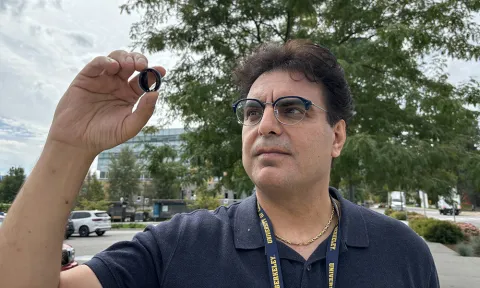UBCO researchers pioneer advanced mechanical heart valve

Sort of like testing a car, a team of researchers at UBC Okanagan has been test driving a number of mechanical heart valves (MHV)—and the one designed in their own lab appears to outperform the others.
Associate Professor Dr. Hadi Mohammadi runs the Heart Valve Performance Laboratory at UBCO’s School of Engineering. He, along with Dr. Dylan Goode, has been testing an MHV created in their lab which may, after clinical trials, supersede mechanical valves currently available for people living with heart disease.
The research, published recently in the Journal of Biomechanics, determines that MHVs may outperform tissue valves under certain conditions.
“This is the first time we’ve been able to make this claim,” says Dr. Mohammadi. “While more testing is needed to fully understand what causes the differences in how each valve performs, we are excited about the potential of this significant achievement.”
Calcific valvular heart disease—when one or more of the heart valves do not open or close properly due to calcification—is projected to affect some 4.5 million people by 2030, making it the most prevalent valvular heart condition in aging populations.
And Dr. Mohammadi explains current options for aortic valve replacement include having a new heart valve—either mechanical or valves made with natural materials such as bovine or porcine tissues—implanted.
Both options come with limitations.
Tissue valves generally perform better than MHVs and provide better blood flow, but last an average of 10 to 15 years, which could require another replacement, explains Dr. Mohammadi. Mechanical valves can last a lifetime, but do not perform as well as tissue valves, requiring patients to take daily blood thinners.
Despite advancements in prosthetic heart valves, an ideal solution remains a challenge.
“Developing a prosthetic valve with optimal hemodynamics and durability would address critical challenges worldwide,” says Dr. Mohammadi. “This research evaluates two emerging MHVs, currently in preclinical and clinical trials, designed to overcome the limitations of earlier models.”
The researchers put their iValve together with another developing valve called Triflo MHV. These two were fully tested during the study with three other valves that are similar to the current industry standard.
In the lab, each valve was tested for flow velocity using a pulse duplicator system that mimics real heart conditions. Each test included 10 cycles, and each valve underwent multiple tests. Results indicate that the iValve and Triflo achieved comparable pressure ratios and significantly lower mean and peak reverse blood flow values than the traditional MHVs. This means blood can flow more smoothly, putting less stress on blood cells, which could reduce the need for blood thinners.
Unlike most MHVs, the iValve allows blood to flow through a single open central orifice, like tissue valves. Other MHVs, including the Triflo MHV, divide the flow into smaller streams, which may increase the risk of flow-related complications.
This gives the iValve a potential advantage in terms of safer, smoother blood flow, says Dr. Goode.
“Overall, both the iValve and Triflo MHV appear to offer better performance than existing MHVs,” he says. “These results show that the new generation of mechanical valves may offer a strong combination of long-lasting performance, better blood flow and lower risk of blood clots—similar to how a natural heart valve works.”
The iValve, designed at UBC, is now being prepared for animal and clinical trials, bringing it one step closer to becoming a reality.



